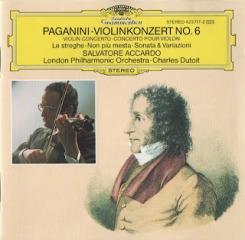Niccolo Paganini - Violin Concerto No.6 & other works (Accardo) [1988]
Niccolo Paganini - Violin Concerto No.6 & other works (Accardo) [1988]

Violin Concerto No. 6 1 1. Risoluto 2 2. Adagio 3 3. Rondo Ossia Polonese 4 Sonata con Variazioni On A Theme By Joseph Weigl 5 Vars On A Theme From 'La Cenerentola' 6 Le Streghe, Op.8 Salvatore Accardo – violin London Philharmonic Orchestra Charles Dutoit – conductor
Violin Concerto No.6. Paganini wrote this concerto to flaunt his violinistic virtuosity as no other music of his time could. In and around melodies that are ardently if not profoundly expressive the soloist gets to show off lines in the violin's highest compass, wide leaps of register, dashing scales and arpeggios, strings of trills, =saltando= bowing, and passages in double stops . The orchestra accompanies discretely and sometimes speaks up in =tutti= passages of its own. Much of the music recalls opera, and the tone is predominantly plaintive. The structure is episodic and the music often jumps rather than flows from section to section.
Although this work carries the number 6 it is actually the earliest of Paganini's surviving concertos. For a long time only a version for violin and guitar was available and Federico Mompellio provided the orchestral accompaniment (published in 1973) on which this description is based.
Violins and flutes lead the the initial melodic statement of the opening =Risoluto= with straightforward ardor. An oboe leads second theme, still expressive although less ardent than the first. Violins soon resume the major melodic responsibility, and the soloist enters with the movement's first theme and wastes no time extending its expression through virtuosic embellishments.
The central =Adagio= holds forth in the major mode with a somewhat hymnal feel. The soloist projects a straightforward singing line with a minimum of virtuosic interpolations, and the orchestra introduces a brief moment of agitation near the end.
The concluding =Rondo ossia polonese= dances for joy (if sometimes cautiously) although it is well aware of the concerto's concerns. The solo violin starts out over a discreet accompaniment. The orchestral violins briefly take up its tune, and then the soloist offers the second strain. Some playfully amusing pauses show up in the refrain's final statement. --- Aaron Rabushka, Rovi
download: uploaded yandex 4shared mediafire solidfiles mega filecloudio nornar ziddu
Zmieniony (Piątek, 07 Marzec 2014 15:27)








